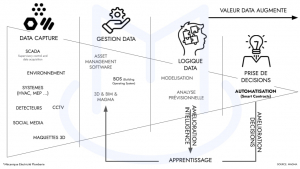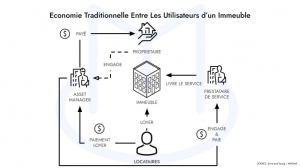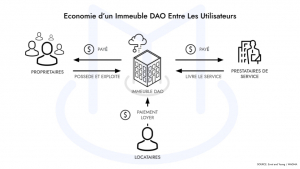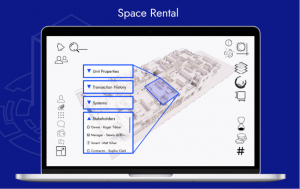Real Estate and Web3 / Mar 07, 2023
Real estate and the Web3 Revolution: is real estate at a technological turnaround?

Health crisis, climate crisis, war in Ukraine and record inflation… here we are in a state of global crisis, with dangers coming from all sides. And, as with every major crisis, paradigm shifts foreshadow new economic models. Once again, the shift seems to come from digital technology and especially from the arrival of Web3.
As an essential feature of the 21st century, the Web is an irreplaceable cornerstone of our society. Declined in 2 iterations, Web1 and Web2, its latest evolution is about to respond to the challenges of our time but also to fill its current flaws with highly robust systems. It is therefore a revolution that the Web is undergoing, bringing numerous evolutions for sector of activity, including the largest asset class in the world: real estate.
Despite its high value and vital role, real estate is suffering from its delayed adoption of digital technology and is being undermined by these multiple tensions and challenges. How could Web3 be a solution to real estate’s many difficulties?
As mentioned in the foreword, the world is facing various crises. Climate change remains one of the most urgent to address, and in this regard, real estate holds its own as it is the most polluting asset class in the world, with over 40% of global CO2 emissions.
Fragmented by various intermediaries and service providers working in silos, stakeholders use their own systems. This results in information asymmetry and therefore a loss of efficiency throughout the value chain. As a result, they have to deploy additional resources to capture and reconcile this information.
With 70% of the world’s population expected to live in urban areas by 2050, the real estate industry faces a major economic and social challenge: improving occupant comfort while controlling operating and maintenance costs. The preservation of natural resources and the reduction of greenhouse gas emissions are now crucial points for buildings, and the recyclability of materials will also be at the heart of this effort.
Moreover, 2050 also characterizes the net zero emissions targets of the Paris Agreement. On the other hand, this would require all new buildings to be net zero by 2030 and all old buildings to be net zero by then… This leaves one wondering.
A digital twin is a digital representation of a physical asset, which enables predictive modeling to provide proactive adjustments.
These twins offer great strategic value to the entire real estate industry. While they optimize operations and improve the customer experience, digital twins allow for the simulation of thousands of complex scenarios and help assess the impact on the building of different decision making.
The digital twin market, valued at USD 10.27 billion in 2021, is expected to reach a value of USD 61.45 billion by 2027 at a forecast CAGR of 34.48% between 2022-2027.
According to ABI Research, the deployment of the same technology would result in $280 billion in savings for property owners and planners by the end of the decade.
Monitoring through the Internet of Things (IOT)
The control and management of urban facilities creates new perspectives, thanks to data captured in real time and actionable information: intelligent sensors, monitoring devices, etc.
Asset management or property listing platforms
Many buildings today use platforms for organizing and managing services and spaces, such as Witco, which serves as a single point of access to all services and spaces in a building: seamless organization of hybrid work, room reservations, visitor management or incident reporting.
Asset management platforms for asset managers such as MYRE, which collects, monitors and analyzes property data throughout the property lifecycle. MYRE provides asset managers with an overview of each property with instant access to reliable data for financial analysis.
Property listing platforms such as Zillow or Seloger where agents and owners can enter information about their properties, without any real validation or authentication.
Building Operating Systems (BOS), the result of a need to standardize data in a building. A BOS makes all the systems in a building communicate with each other.
Artificial Intelligence, capable of analyzing and extracting information to automate or predict events.
Thanks to these advances, we are able to design connected buildings that are easy to operate and control their energy consumption or production, but also to improve existing ones. This is the vision of the “smart building”.
To become smart, the building had to be equipped with an infrastructure that allows the collection and analysis of data to extract intelligence and then a decision (Figure 1).

In terms of information and payment flows, the current building economy is fragmented and relies on the asset manager. Currently, owners must entrust their assets to an asset manager who in turn hires service providers. On the other hand, the tenant pays his rent to the asset manager who pays it back to the owner.
Each party uses its own software and maintains its own version of the building with no fluid transmission of information (diagram 2). They thus hold each one a different version of the building and must constantly check if the information which they collect corresponds well to reality.

If the sector is to be transformed to ensure lower operational costs, it will be necessary to develop new mechanisms to optimize the resources of all building stakeholders.
Given the contemporary challenges, the various players are forced to offer objective information on their buildings and their performance and are showing a global awareness.
Despite the context and the stakes, never in history has man had so many tools at his disposal to optimize the design, construction, management and transmission of buildings. At the dawn of smart cities, connected buildings are a necessity and the arrival of Web3 is a perfect opportunity to organize the governance of this data.
Web3 applied to real estate
In a world where data is king, its reliability will determine the quality and robustness of new digital infrastructures.
To understand this, let’s recall that Web3 is based on Blockchain technology, a shared register that contains all previous transactions and data in an immutable way.
Unlike Web2, Web3 is decentralized and belongs as much to its developers as to its users. It represents a new era of decentralization, immersion and community. Thanks to its underlying technology, it paves the way for smart contracts, non-fungible tokens, AR/VR and the metaverse.
Thus, it is the blockchain that enables the creation of digital assets and applications between participants.
In Web3, each object can take the form of a realistic (digital twin), figurative (avatar) or even non-realistic graphic representation. Thus, these objects or assets can be found in virtual universes such as the Metavers.
Interoperability is by design since Web3 platforms are decentralized and all participants agree to share data under certain pre-defined conditions.
Let’s recall here the main components of the Web3 :
- Digital Identity: it is imperative to have an initial verification of the entity participating in the network through Know Your Customer or Business and Anti Laundering (KYC/KYB/AML) procedures and to ensure that it will be that person who will participate in the transactions.
- Wallets, electronic wallets in which digital assets are stored. The building will also have its wallet.
- Blockchain, these shared data registers where participants create assets and exchange them: Bitcoin, which needs no introduction, Ethereum, which should solve its energy overconsumption problem with The Merge in September 2022, Tezos, Binance, Polkadot and many others.
- Assets can take 3 forms: fungible tokens (FT) like ERC20 on Ethereum which are like a participation in the governance of the project and can be traded on a secondary market. Non-fungible tokens (NFT) are unique and guarantee digital property, protect the intellectual property of creators and can give rights in the real world. And finally the non-transferable or intuitu personae (Soul Bound Token SBT) which are attached to a person and his achievements.
- The rules that govern these exchanges are made in the form of code or Smart contracts which are pre-established and automated contracts under the data collected between participants.
- At the governance level, DAOs or Decentralized Autonomous Organizations are new types of businesses that are more like cooperatives than corporations. A DAO is an organizational structure represented by rules encoded in smart contracts on a blockchain. These smart contracts are fully transparent and controlled by the DAO’s shareholders. They define the business logic, while the underlying blockchain acts as a secure digital ledger, enforcing consensus rules and tracking all interactions immutably.
In a DAO, there are no managers or directors. Leadership roles are more fluid and impermanent, giving more opportunities for members to rise.
This shift from hierarchical structures to flat, distributed ecosystems run by stakeholder communities rather than boards will have a profound impact on the real estate business.
It is therefore a question of creating the infrastructure for the governance and exploitation of these blocks of data forming assets in the form of automated contracts between participants.
We speak of tokenization of real estate. This tokenization can take various forms.
For example, the tokenization of the shares of real estate companies in which the buildings are housed. This is what Digishares or RealT does. This allows more agility in the management of the cap tables and in the transmission of these assets from an administrative point of view. This does not solve the problem of information asymmetry between the parties, nor the lack of verification of the building itself. In this case, the shares are transferred and not the real estate, which remains in the same company.
The tokenization of the constituent elements of the building which consists in using the twin according to the methodology of the BIM and to reproduce all the elements of the building in the form of NFT to have a state in real time of all the elements of this one (or at least according to the updates). This mechanism allows to take all the quintessence of the blockchain because it allows to connect the elements to their creators and to connect areas to objects and providers to elaborate automated contracts according to the needs and the state of these objects (Magma Diagram 4)
The NFT contains the information to authenticate the creator and owner of a digital asset and the cryptography and timestamp to guarantee the existence of a document or event.
For example, an air conditioning system can become a digital asset represented in the twin by a 3D and connected in the field with a QR code that can send maintenance information, make connections with other elements of the building but also to other providers and service providers.
A lease can also be a digital asset. It will contain the information of a lot or a building and the information about the lessee with the guarantees and conditions of use of the real asset.
An inventory of the objects that make up the building and their condition will make it possible, for example, to set up a passport for the recyclability of materials
“The combination of the metaverse and a decentralized web has the potential to radically transform business models and the labor market”
Let’s imagine for a moment what tomorrow’s real estate could be like. The building is equipped with sensors and the different stakeholders all use software that allows them to collect data and view their KPIs. Instead of reporting to the asset manager, they all use the same digital twin to which they send the data when it has been verified and recorded in the blockchain. Depending on their status, each stakeholder has different rights and access to the twin. The building via its digital twin will thus be able to become an entity in its own right, autonomous and capable of ordering a service and making a payment according to the rules established between the parties in the DAO (Diagram 3).

It is with this type of organization that facilitates everything from building design to facility management and financial transactions through smart contracts that we will be able to take advantage of the power of blockchain.
We are witnessing the birth of new business models where value for money is rewarded, where data is contextualized and certified and therefore can be valued.
At the same time, we are seeing an effort to standardize building services with environmental labels (BREEAM, LEED, etc.) or for their ability to develop homogeneous and sustainable services with, for example, the R2S (Ready to Service) label of the SBA (Smart Building Alliance for Smart Cities) or even the open BIM or IFC standards.
Conclusion
For the first time in history, the real estate industry is able to collect volumes of information and analyze it in real time from the design phase to the operation of buildings.
A concerted and seamless effort is going to be required for the industry to undergo a major transformation and apply these new holistic, user-centric and environmentally friendly models.
It is not a question of opposing Web2 to Web3, which is in fact an evolution rather than a rupture. It is by using the systems resulting from Web2 and by taking advantage of the possibilities offered by these new data sharing modes that we will be able to build a robust and agile infrastructure, ready for the challenges of our time.
We are fortunate that organizations like the SBA are able to mobilize all of the smart building trades.
If the challenges are numerous, so are the opportunities, and in the era of smart cities, cities like Miami, Amsterdam, Dubai and Barcelona have already entered the race to build the infrastructure of the city of tomorrow.

Matthieu is an entrepreneur specializing in Web3 technologies applied to Smart Cities, winner of the City of Miami Keys for the Miami Beta City project. Co-Chair of the Innovation Committee at the Miami Dade Beacon Council, he creates in 2019 the Florida Blockchain Foundation with Mayor Francis Suarez. He is currently the CEO of Magma a startup developing a Web3 platform for digital twin creation. Matthieu is also the Chairman of the SBA Blockchain Commission.